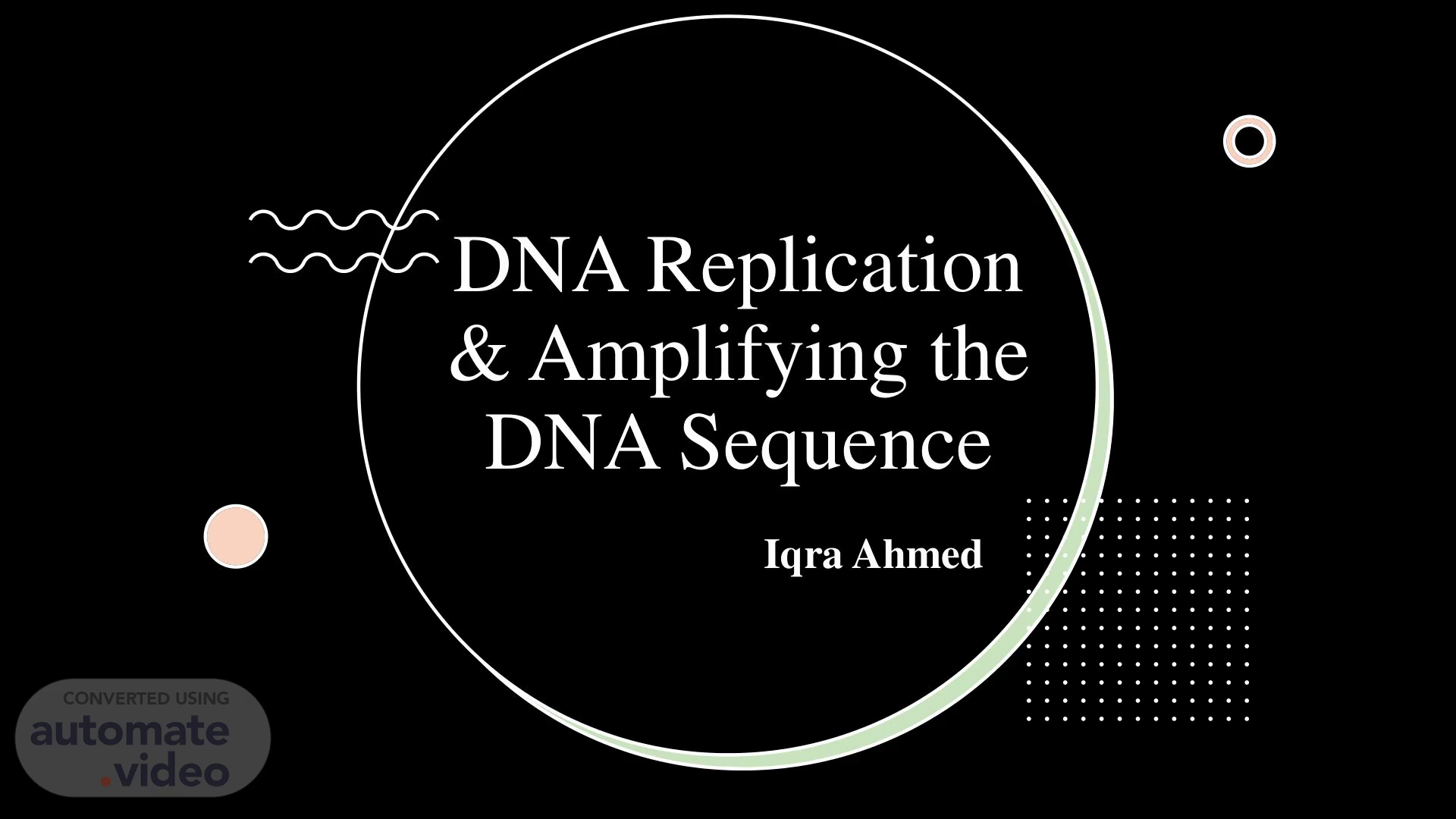Scene 1 (0s)
DNA Replication & Amplifying the DNA Sequence Iqra Ahmed.
Scene 2 (6s)
The structure of DNA immediately suggested to Watson and Crick a mechanism by which DNA can be copied. They proposed that during this process, known as DNA replication, the original DNA strands are used as templates for the synthesis of new DNA strands..
Scene 3 (21s)
Meselson and Stahl Considered Three Proposed Mechanisms of DNA Replication 1. Semiconservative mechanism • In this model, the double-stranded DNA is half conserved following the replication process. The new double-stranded DNA contains one parental strand and one daughter strand. This model is consistent with the proposal of Watson and Crick. (a) Semiconservative mechanism. DNA replication produces DNA molecules with 1 parental strand and 1 newly made daughter strand..
Scene 4 (38s)
Meselson and Stahl Considered Three Proposed Mechanisms of DNA Replication 2. Conservative mechanism • Following DNA replication, the original arrangement of parental strands is completely conserved, and the two newly made daughter strands are also together following replication Conservative mechanism. DNA replication produces 1 double helix with both parental strands and the other with 2 new daughter strands.
Scene 5 (55s)
Meselson and Stahl Considered Three Proposed Mechanisms of DNA Replication 3. Dispersive mechanism • After DNA replication is completed, segments of parental DNA and newly made daughter DNA are interspersed in both strands. (c) Dispersive mechanism. DNA replication produces DNA strands in which segments of new DNA are interspersed with the parental DNA..
Scene 6 (1m 11s)
N15 (NH4Cl) media, for several generations E. coli Harvest cells ....x Harvest E.' cells E. coli N15 media E. coli N15 media N14 media E. coli N15 media E. Coli doubles every 20 mins N14 media 00 0 Harvest cells N14 media Harvest cells every 20 mins Isolate DNA CSCI Density gradient centrifugation.
Scene 7 (1m 23s)
N15 Heavy Time O mins O Generation CSCI density gradient centrifugation N14 appears here N15 N14 N14 In ermed ate Time 20 mins ISt Generation E. Coli doubles every 20 mins QBB.
Scene 8 (1m 33s)
CSCI density gradient centrifugation N 15 N14 N15 Heavy Time O mtns O Generation In ermed ate Time 40 mins 2nd Generation N14 N14 E. Coli doubles every 20 mins N14 N14 QBB.
Scene 9 (1m 42s)
N 15 Heavy Time O mtns O Generation CSCI density gradient centrifugation Ni4 25% In ermed ate Time 60 mins 3rd Generation E. Coli doubles every 20 mins CD Okazaki experiment QBB.
Scene 10 (1m 51s)
DNA Replication Proceeds According to the AT/GC Rule • Replication relies on the complementarity of DNA strands according to the AT/GC rule. • During the replication process, the two complementary strands of DNA separate and serve as template strands for the synthesis of daughter strands of DNA • Individual nucleotides hydrogen-bond to the template strands according to the AT/GC rule: An adenine (A) in one strand bonds with a thymine (T) in the opposite strand, or a guanine (G) bonds with a cytosine (C). • Next, a covalent bond is formed between the phosphate of one nucleotide and the sugar of the previous nucleotide. • End result is that two double helices are made that have the same base sequence as the original DNA molecule.
Scene 11 (2m 22s)
DNA Replication.
Scene 12 (2m 27s)
Polymerase Chain Reaction (PCR) Developed by American biochemist Kary Mullis in 1985 The goal of PCR is to make many copies of DNA from a defined region, perhaps encompassing a gene or part of a gene..
Scene 13 (2m 39s)
Materials required for PCR 1. Primers • Two different primers are needed that are complementary to sequences at each end of the DNA region to be amplified. • These primers are usually about 20 nucleotides long. • One primer is called the forward primer, and the other is the reverse primer..
Scene 14 (2m 55s)
deoxyNucleotide TriPhosphates (dNTPs) 2. dNTPs are the essential building blocks of nucleic acid molecules, and as such are necessary components of PCR mixes as no new amplified DNA could be generated without them..
Scene 15 (3m 7s)
Taq polymerase • DNA polymerase called Taq polymerase is isolated from the bacterium Thermus aquaticus, which lives in hot springs and can tolerate temperatures up to 95°C. • A heat-stable form of DNA polymerase is necessary because PCR is conducted at high temperatures that would inactivate DNA polymerase from most other bacteria..
Scene 16 (3m 23s)
Cycle 3 Repeat denaturation, pnmer annealing. and pomer extensjon. With each successive cycle, the relatrve amount of DNA fragments that end exact* at both pnmer Sites (marked Increases. Therefore. after many cycles, the vast majority of DNA fragments contajn onty the reglon that IS flanked by 2 pnmer Sites. cycle 2 Repeat denaturation, pomer annealing. and pnmer extension. Cycle 1 Denaturation: Heat the DNA to separate strands. Primer annealing: Lower the temperature to allow primers to blnd to the template DNA Primer extension: Incubate at a higher temperature to allow the synthesjs of the complementary strand. -950C Forward pnmer verse pnmer -720C.
